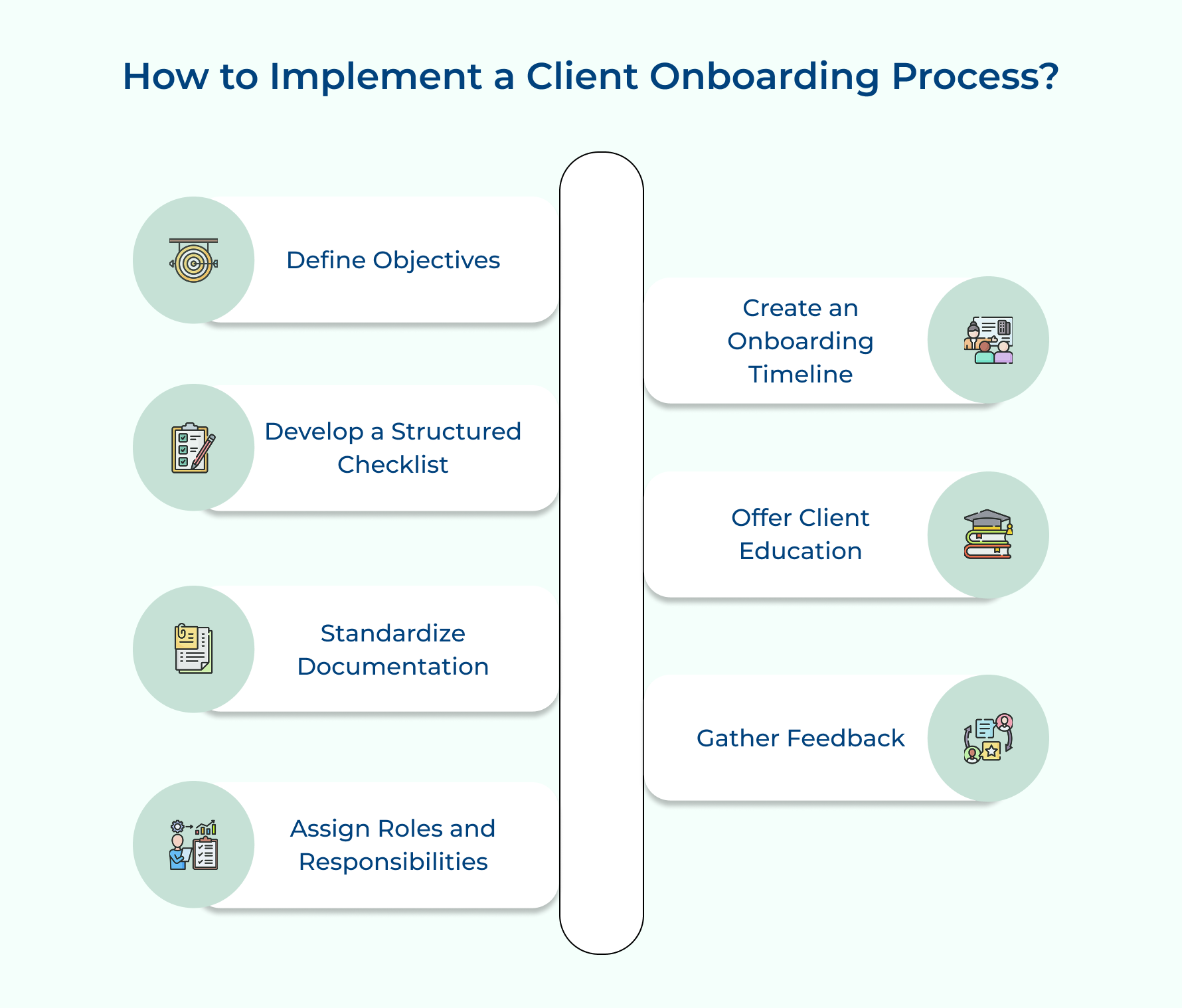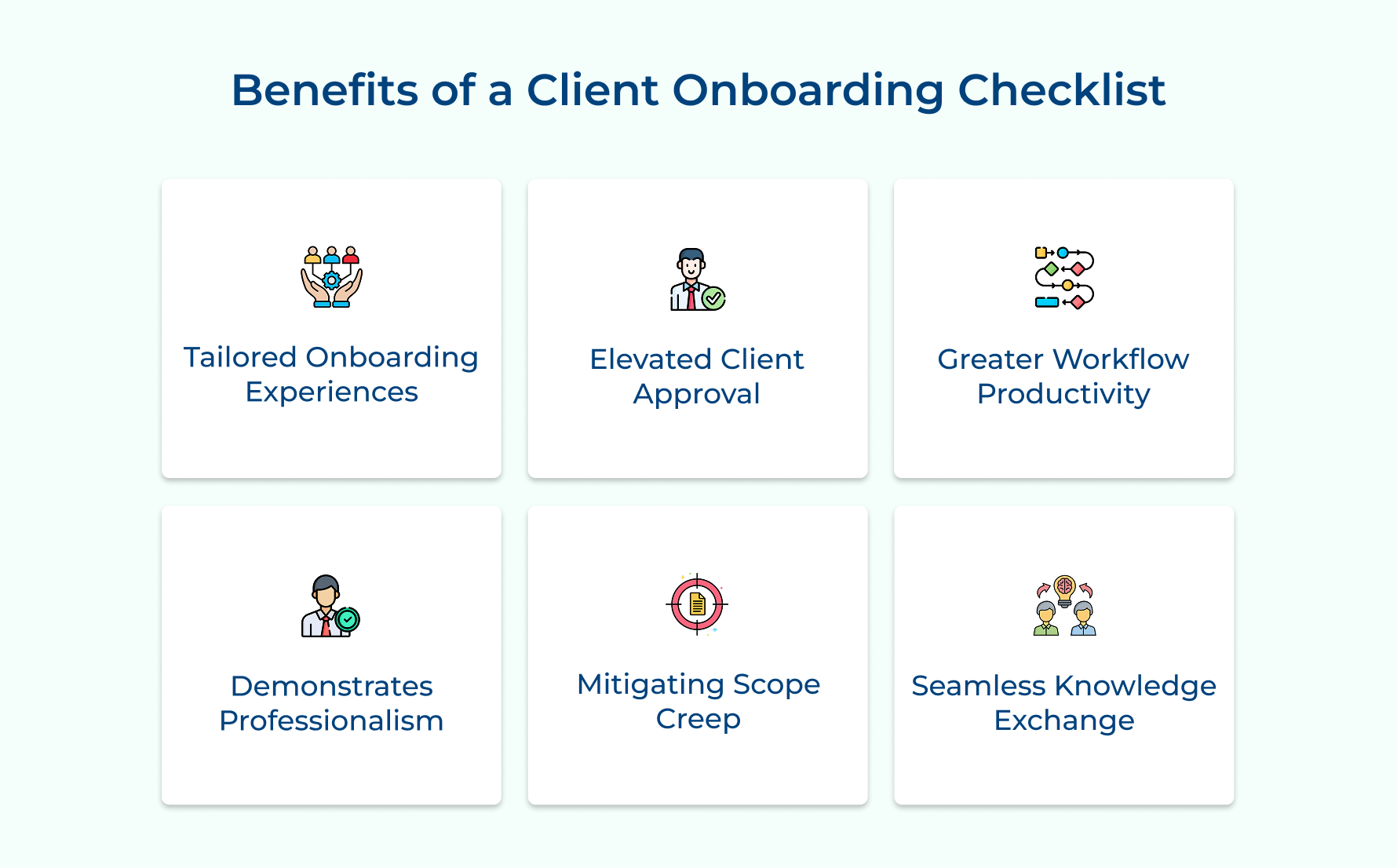9 Step Client Onboarding Checklist You Should Know
- What is a Client Onboarding Checklist?
- Onboarding Essentials: What to Include in the Client Onboarding Checklist
- How To Implement a Client Onboarding Process?
- Benefits of a Client Onboarding Checklist
- Challenges in Client Onboarding & How to Address Them
- Maximizing Profits with a Structured Onboarding Process
- FAQs about Client Onboarding Checklist

Key Highlights
- A structured client onboarding checklist is all about aligning expectations and building strong client relationships.
- Clear communication protocols prevent confusion and align with client goals.
- Personalized onboarding experiences build stronger relationships by addressing specific client expectations.
Congratulations on bagging in the big project!
But, what next? You can’t just start working on the goals and deadlines, the client needs to know a little more than what you do. They need to know how you get things done.
The client onboarding checklist is the perfect answer to ensure everybody starts off on the same page and well!
A well-crafted client onboarding checklist is essential for establishing a seamless and effective onboarding process.
We will help you implement a systematic approach with a customer onboarding checklist, ensuring that you not only meet client expectations but also encourage strong, lasting relationships from day one.
What is a Client Onboarding Checklist?
A client onboarding checklist is a structured tool that outlines the necessary steps and processes to integrate new clients into a service-based business. It ensures that all essential tasks are completed, from initial communication to project kickoff, providing a seamless experience for both the client and the service provider.
Effective client onboarding sets the tone for the entire client relationship, helping to build trust and confidence from the very beginning. A well-executed onboarding process leads to improved client satisfaction, retention, and increased revenue.
Key Objectives:
- Streamline processes: Establish a clear framework that minimizes confusion and maximizes efficiency during the onboarding phase.
- Set clear expectations: Ensure that both the client as well as the service provider understand roles, responsibilities, and deliverables from the outset.
- Facilitate communication: Create established channels for ongoing dialogue, encouraging a collaborative relationship.
Onboarding Essentials: What to Include in the Client Onboarding Checklist
An effective client onboarding checklist template ensures all necessary steps are taken to integrate clients smoothly. Key components create clarity and efficiency. Here are the essentials.
1. Pre-onboarding Preparation
Getting ready for a new client’s arrival is all about preparation! Pre-onboarding sets a solid foundation for smooth integration, helping your team make a fantastic first impression. Here’s what you should do,
- Create checklists for internal team readiness to cover all bases.
- Build welcome packages tailored to different types of clients, making them feel valued from the start.
- Brief relevant team members on the new client so everyone is prepared.
2. Initial Client Consultation
The initial consultation is where you establish rapport as well as get to know your client’s needs, expectations, and goals. This is your first chance to showcase your expertise and set the tone for a positive relationship.
Think from a customer journey perspective and develop a structured agenda. Come up with a client onboarding questionnaire to improve your customer experience.
3. Information Gathering
Getting detailed information from the client is key to delivering personalized service and avoiding miscommunication. Gathering all the right data upfront saves time and sets a strong foundation for project success.
- Use comprehensive, user-friendly questionnaires to make data collection easy.
- Implement digital tools for smooth data storage and access.
- Verify information to ensure accuracy and completeness.
4. Define Project Scope and Goals
Defining a clear project scope and setting goals helps align your agency’s efforts with the client’s expectations. It ensures that everyone is on the same page, and it also prevents the project from expanding beyond initial agreements.
- Collaborate on a project charter using online tools for transparency.
- Set SMART goals (Specific, Measurable, Achievable, Relevant, Time-bound) with the client.
- Create visual project scope maps to make objectives clear and accessible.
5. Establish Communication Protocols
Strong communication keeps everyone aligned and prevents confusion. Clear protocols outline how and when updates happen, the preferred communication channels, as well as response time expectations.
What crucial steps should you take to maximize customer satisfaction?
- Implement a project management tool for centralized communication.
- Create a communication plan that defines channels, frequency, and response times.
6. Resource Allocation
Effective resource allocation ensures the right people are assigned to each project. It keeps workloads manageable and deadlines achievable while leveraging your team’s skills to their fullest potential.
Use resource management software to plan and track resource allocation. Assess team member skills to match tasks to strengths. Set clear roles and responsibilities for each team member.
7. Initial Deliverables
The first deliverables make a lasting impression and build the client’s confidence in your work. Quality initial outputs demonstrate your agency’s expertise and create early momentum. Here are the next steps you need to consider,
- Standardize formats for initial deliverables but leave room for customization.
- Implement quality checks to ensure high standards.
- Present early drafts with clarity to help the client see the value and impact.
8. Feedback and Evaluation
Regular feedback and evaluation support continuous improvement as well as show that you value the client’s input. It’s an ongoing loop that strengthens your service delivery and enhances client satisfaction.
Schedule regular check-ins using automated reminders. Provide easy-to-use feedback forms for consistent input. Analyze feedback trends to spot improvement areas and make necessary adjustments.
9. Documentation and Record Keeping
Maintaining organized documentation is key to transparency and continuity. Well-kept records support seamless knowledge transfer and provide a go-to resource for future reference.
Use a cloud-based document management system for easy access and sharing. Create standardized templates to ensure consistency and set up regular audits to keep all documents current as well as useful.
How To Implement a Client Onboarding Process?
A structured onboarding process is vital for client success and satisfaction. Knowing how to implement this effectively can streamline operations. Here’s how to do it.
1. Define Objectives and Goals
Clear objectives and goals set the stage for a successful onboarding journey. They align your agency’s efforts with the client’s expectations and provide a roadmap for the entire engagement.
By defining what you’re aiming to achieve, you can prioritize tasks, allocate resources effectively, and ultimately measure the success of the onboarding process.
2. Develop a Structured Checklist
A checklist brings structure as well as consistency to onboarding, ensuring that no steps are missed and that everyone stays on track.
The checklist acts as a central guide for the team, helping with task assignments and progress tracking. Plus, it keeps the client informed and enhances their onboarding experience.
- Break down the checklist into phases, like pre-onboarding, kickoff, implementation, and review, for smoother management.
- Use a digital tool for real-time updates and easy collaboration.
3. Standardize Documentation
Standardized documentation keeps things organized, professional, and consistent across all client onboarding processes. Using pre-set forms, templates, and guides, helps you collect as well as organize client information more efficiently, saving time while preventing confusion.
- Create a comprehensive welcome packet with forms, FAQs, and essential agency information to send to new clients.
- Set up a document management system so the team always has the latest versions on hand.
4. Assign Roles and Responsibilities
Assigning clear roles helps everyone know what’s expected of them, reducing confusion and promoting accountability. When each team member understands their part in onboarding, the whole process runs more smoothly.
Set up a responsibility matrix outlining who’s responsible for each onboarding step. Assign a dedicated onboarding manager to oversee the process and serve as the main point of contact for the client.
5. Create an Onboarding Timeline
A well-defined timeline gives structure and sets clear expectations for both your team as well as the client. It ensures tasks are completed on time, resources are allocated effectively, and clients know what to expect at every stage.
Use project management software to create a visual, shareable timeline. Include buffer time for unexpected delays or client requests to keep the timeline realistic and manageable.
6. Offer Client Education Materials
Educational materials help clients understand your agency’s processes and tools, making onboarding smoother as well as more efficient. These resources answer common questions and empower clients to engage confidently with your team, creating a more satisfying experience.
Develop short video tutorials to walk clients through key agency processes. Prepare an FAQ document that addresses common questions and concerns, keeping everything accessible.
7. Gather Feedback Regularly
Feedback helps you identify and fix issues early, improving the client experience as you go. Regular check-ins show your commitment to client satisfaction and provide insights for enhancing your onboarding strategy.
- Schedule weekly check-in calls to collect immediate feedback and address any concerns.
- Use automated survey tools to send quick, targeted feedback forms at key points in the onboarding journey.
Benefits of a Client Onboarding Checklist
Implementing a client onboarding checklist brings numerous advantages, from enhancing client satisfaction to improving retention rates. Here are the benefits.
Tailored Onboarding Experiences
Well-structured checklists allow businesses to customize the onboarding process for each client. Personalization addresses specific client needs while ensuring a more relevant and engaging start to the relationship.
Elevated Client Approval
Following a comprehensive checklist demonstrates thoroughness and attention to detail. The organized approach impresses clients and encourages trust in the company’s capabilities from the outset.
Greater Workflow Productivity
Standardized onboarding checklists streamline the entire process and reduce redundancies. Team members can focus on value-added tasks while increasing overall productivity and enabling smoother transitions into project work.
Demonstrates Professionalism
Systematic onboarding processes showcase a company’s expertise and organizational skills. Professional and reliable partners are reflected through their commitment to quality as well as client care.
Mitigating Scope Creep
Clearly defining project parameters during onboarding helps manage client expectations effectively. Businesses can prevent misunderstandings and reduce the risk of scope creep through upfront clarity.
Seamless Knowledge Exchange
Onboarding checklists facilitate effective information gathering between the client and the business. All necessary data and objectives are collected upfront to enable smoother collaboration as well as accurate project planning.
Challenges in Client Onboarding & How to Address Them
Client onboarding can present various challenges that hinder success. Identifying these obstacles and knowing how to address them is essential. Here are the challenges and solutions.
Unclear Client Expectations
Many clients enter partnerships with vague or unrealistic expectations.
How to address: Agencies should conduct thorough discovery sessions early in the onboarding process. Use these meetings to clarify project scope, deliverables, and timelines. Create a detailed project charter or statement of work that both parties review and sign off on, ensuring alignment from the start.
Inadequate Resource Allocation
Underestimating the resources needed for smooth onboarding can lead to delays and frustration.
Fix it through: Combat it by developing a comprehensive resource plan during the onboarding phase. Assess the client’s needs carefully as well as allocate appropriate staff, time, and tools. Implement a system to track resource utilization and adjust as needed, ensuring the right people are available at the right time.
Knowledge Transfer Gaps
Critical information often falls through the cracks during onboarding, causing misunderstandings later.
Solve it by: Mitigate it by creating a structured knowledge transfer process. Develop detailed questionnaires and conduct in-depth interviews with key client stakeholders. Use collaborative tools to document as well as share information across teams. Regularly review and update this knowledge base throughout the client relationship.
Inconsistent Process
Lack of standardization in onboarding can lead to varying client experiences and internal confusion.
How to fix: Establish a clearly defined, repeatable onboarding process. Create checklists and templates for each stage of onboarding. Train all team members on the process and use project management tools to track progress. Regularly review and refine the process based on feedback as well as outcomes.
Lack of Proper Documentation
Poor documentation can result in miscommunication and accountability issues.
Address it by: Implementing a robust documentation system. Create templates for all key documents, including contracts, project plans, and communication logs. Use a centralized, accessible platform for document storage and version control. Assign clear responsibilities for maintaining and updating documentation throughout the client lifecycle.
Maximizing Profits with a Structured Onboarding Process
A client onboarding checklist is essential for ensuring seamless integration of new clients into your agency or professional services workflow. Providing a structured approach minimizes confusion and establishes clear expectations from the outset, leading to higher client satisfaction.
Implementing an effective onboarding checklist involves gathering vital client information, defining project scopes, and establishing consistent communication channels. An organized process enhances the client experience and encourages stronger relationships, setting the foundation for long-term partnerships.
Incorporating a comprehensive client onboarding checklist can significantly improve operational efficiency and resource management. A well-executed onboarding experience lays the groundwork for successful collaboration and mutual growth.
Limit time — not creativity
Everything you need for customer support, marketing & sales.
Neeti Singh is a passionate content writer at Kooper, where he transforms complex concepts into clear, engaging and actionable content. With a keen eye for detail and a love for technology, Tushar Joshi crafts blog posts, guides and articles that help readers navigate the fast-evolving world of software solutions.


